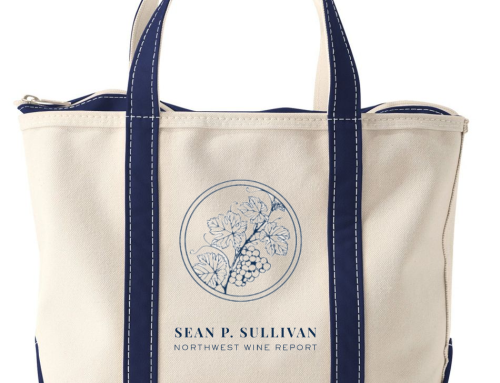
Syncline Wine Cellars, located in the Columbia Gorge, uses both screw caps and glass stoppers. Winemaker James Mantone says, “We have been proudly cork-free for four years. Sold our corker two years ago, never looked back.” In terms of making the decision to switch from cork, Mantone says, “We were encountering too many purchased wines that were either tainted or had cork failure and were concerned what the consumer reaction might be to a similar problem in our wines.”
Mantone continues saying, “Beyond the TCA issue is the inconsistency in cork. Some great research out of Australia showed that there could be as much as 1,000x difference in oxygen transmission rates in a single bag of purchased corks. How do you attend to this as a producer, or anticipate its affects on your cellared wine as a consumer?”

Mantone continues to taste wines from the original trials and evaluate the closures. He says, “A six year old Subduction Red is far fresher under Stelvin than under cork, and has begun to develop secondary bottle aromatics while maintaining brighter fruit than the cork finished wine.” In terms of consumer response, Mantone says, “When we first introduced the screw cap there was a little resistance from the consumer, but by now it has mostly evaporated.”
Mike Sharadin of Northwest Totem Cellars also uses glass stoppers. In deciding to use an alternative closure he says, “I read about the closure within a week of having a very nice personal bottle of Penfold RWT corked. So seeing it was an elegant solution though slightly more expensive than premium cork, I rationalized stepping up the cost as a cost I did not have to incur later in replacing product or losing customers.”
Sharadin has seen a positive response from consumers. “Consumer response has been amazing!” he says. “They remember the bottle for obvious reasons and have a high stickiness in leaving restaurants with a stopper in their pocket. Additionally, we now sterilize those returned to us in the winery and reuse them. About 3,000 have been returned in our ‘customer loyalty’ program that is simply use, reuse.”
Prosser’s Airfield Estates uses screw caps for its wines. Winemaker Marcus Miller was inspired to use screw caps after talking with winemakers from New Zealand and Australia. Miller says, “One of the first questions I would ask these winemakers was about the screw cap closure. Eventually I was won over by all of the wonderful arguments they put forward.” In terms of consumer response, Miller says, “We have only had a hand full of people that maintained opposition to screw caps after explaining to them the benefits it has over using cork as a closure. Most of these people are cork salesmen.”
Perhaps the largest winery in Washington State to use screw caps is Hogue Cellars. Hogue conducted a multi-year study looking at the effectiveness of various types of closures (see additional information here). The winery concluded that screw caps held fruit and maintained freshness better than cork or synthetics. Hogue brand wines, which account for seventy percent of the winery’s production, are now under screw cap. The winery has not seen any adverse consumer response.
Winemaker Thomas Glase at Walla Walla’s Balboa Winery started out using Stelvin screw caps but recently made a change to conglomerate corks. Glase says, “When we started this little adventure in 2005 we felt that Stelvin closures were the best fit for us. Our wines were early to market and at the time no one else was using them. We never had any problems with them. Last year for the 2008 vintage we decided to go to a conglomerate cork. We bottled half of the syrah and half of the merlot with each. As it turned out the wines with the conglomerate cork sold first.”
Glase’s decision to switch to conglomerate cork was not just based on a difference in consumer response. It was also based on environmental concerns. Glase says, “The conglomerate cork is made from the left over cork bark after the main corks have been punched. They are 98% TCA free and cost half of what a Stelvin closure costs. They also take one-third the energy to produce. We also eliminated the foil. In this business I would say 100% of what we create turns into waste, so we wanted to minimize our impact on the environment, and I think we have.” Glase says consumer response has been positive.
Walla Walla’s Dusted Valley Vintners has been a major advocate for screw caps. In deciding to use screw caps, Corey Braunel says of cork, “It is an organic material with variability in structure which leads to variability in the transfer of oxygen into the wine which could create bottle to bottle differences or destroy the wine completely. We also know that 1 in 20 corks (conservative) will be tainted by a chlorine derived molecule called 2,4,6-trichloroanisole (TCA).”
Braunel says, “We were the first winery in Washington State to use screw caps on 100% of our bottlings starting with the 2005 vintage. We’re a small family-owned winery that can’t afford the risk of losing a Dusted Valley convert because of a bad cork. Over 80% of folks don’t even realize they may be drinking a tainted bottle. But, what they do know is they don’t like what’s in the bottle of a tainted cork.”
Braunel says that customer response has been extremely positive – with one exception. He says, “We’ve only had one guy in four vintages give us a hard time about abandoning cork. He said, ‘it took the romance out of it for him.’ His wife was standing there with him and she rolled her eyes at me. So, I said, ‘Forgive me but shouldn’t the romance happen after the bottle is gone? I guess I don’t get what’s romantic about the ‘pop’ of a wine bottle.’ His wife damn near died on the spot and he was a good enough sport in that he said, ‘OK you got me!’ He joined the Stained Tooth Society and purchased six bottles.”
See a recent Wall Street Journal article on plastic corks.
Also see a recent post from the 30 Second Wine Adviser which contains a must see picture from a ten year study.







Sean,
I was waiting for your second act on the non-corks. It was interesting to read about the conglomerate cook. Seems like it's the
greenest way-environment-wise and money-wise. I'm familiar with the glass corks-great for re-stopping a half bottle. And they are classy (in a glass-sort of way). Like all good ideas that go against traditional ways, it will take a long time before the cork goes away.
I personally don't have a problem with screw-caps. Wine is just as good. Never need a cork-screw. And I've got more than enough corks to make everyone a trivet or goofy looking wreath!-cityroute16
Sean,
Great blog topic. We at Overbluff Cellars in Spokane decided to use glass stoppers as well. The main reason we chose glass corks is we eliminate the chance of TCA which is cork taint. 3 to 5% of all bottled wine is "corked" which gives the wine a "off" flavor or "mousey" smell and taste. While most winery's are choosing screw cap closures to eliminate this, we felt that screw caps didn't have the "romance" that needs to be associated with wine. We did some more research and found the glass stoppers like Whitehall Lane winery in Napa uses on their reserve Cabernet Sauvignon.
Aren't most wines consumed within a few hours of purchase? Sure, the wines may have been sitting on a shelf for a few months, but that should not make a significant impact on how that wine tastes.
An "alternative closure" appears to a major advantage with the 1% of wines that benefit from cellar time. Of course, the people who drink those wines only know cork like it's "comfort food".
Cork represents the 'old generation'. Stelvin and glass and everything else will be embraced by the new generation as "theirs" and "better". It's also a novelty but that aspect will eventually fade. And, it's still possible to get taint. ~WAwineman
I'll just add one more thing. In that all important classy, multiple winery, wine tasting event where the inevitable cork war breaks out from boredom, what would you rather have on your table… cork, screw cap, or glass? Just saying..
Cityroute16, indeed the conglomerate corks sound intriguing. Although as Thomas mentions, you still have some TCA issue to contend with. Thanks for the comment!
Overbluff Cellars, thanks for the comment and welcome to the world of Washington wineries! Excited to try your wines.
WWM, good point about so many wines being consumed shortly after purchase. For many, the effect of alternative closures on aging is a non-issue. And indeed there are no magic bullets as screwcaps and glass closures have potential issues. After having had so many TCA flawed bottles, at the moment I feel like at least it would be different! I'm sure I'll regret saying that someday. Thanks for the comment.
To Mike, my man…I don't care if the bottle is stuffed with feathers. As long as the wine is sound and I am in good company with good food, that's all that matters.
And, next time, I'm buying you a bottle of Potlatch over at Village Wines! ~WAwineman
Sean,
Great post! It has all but been written in stone that when applied properly the screw cap is a better short term and long term closure than cork. Of course you need to make clean wines to avoid reduction issues…but that happens under cork as well. The wines develop all the bottle bouquet cork wines do while maintaining freshness and fruit. What real scientific argument is left? Maybe how quick do you want your wine to age?
Cheers, Chad
Thanks for the input from Dusted Valley as well as the comment Chad. Much appreciated.
Sean,
I hadn't ever seen the glass corks until last Saturday when Chatter Creek released their latest Malbec. I was really intrigued by it and brought some home. It is really easy to open and for short term storage, the stopper fits back nicely. The wine was great of course too. I think I'm sold.
-Stuart
Stuart, indeed Chatter Creek uses the glass stoppers as well. Glad you got to check them out. Only drawback with the glass stopper is when you try to open one with a rabbit!
Hi Sean,
I'm Mark from BellaSvago, the firm that makes the TorkScrew.
We are a small company committed to beautiful entertainment or, "Bella Svago" in Italian. One of the main uses of the TorkScrew is to assist people with hand dexterity issues to open virtually any type of bottle. though we actually prefer that people primarily use it to open wine :-)
The best way to really understand the gadget is to check out the you tube video at
In our opinion, it is simply the most versatile device for opening champagne, screwtop, cork and plastic enclosures and with the champagne, it stops you from worrying about the cork flying all over the place and putting someones eye out! We really loved that it gets rid of the 20 wine and bottle openers you have in your junk drawer…and you do have 20 don't you Sean? And it is always there on the fridge where you can find it when a glass of wine ..fast ..is important…like after work, sunny days…ok I admit it…almost anytime for me :-)
In closing, it not going to solve world hunger but perhaps just make the opening of screwcap wines a little easier for those with disabilities and a little more elegant for those who want to serve great screwcap wines with just yanking the top off.
Warmest Regards,
Mark
CAUTION: Shameless self promotion begins here!
Find out more at http://www.torkscrew.com
I've stopped buying Columbia Crest (among WA wineries) because of the high number of tainted bottles I end up with. Whenever I'm deciding how many of a bottle to purchase, I now buy more when it's under "alternative" closures. It's about time more U.S. wineries recognized the reality that consumers are fed up with defective stone-age packaging. Here's another angle: Cellar that prized Cab blend for 10 years only to open it and find it's corked. Sure, most wineries will "replace" it, but they won't offer you the same old vintage. And ask yourself, would you buy the vintage they DO offer you? Or did you buy the older vintage specifically because of the characteristics from that vintage? While a like-for-like replacement seems "fair" on the surface, it's not, really. From a consumer's POV, later vintage replacements aren't good enough, because they don't represent the experience you should have had with the older bottle. To all the wineries listed above, using alternative closures, you are now on my shopping list. :-)
Don, thanks for the comment. I haven't personally had any issues with CC but definitely understand how the problem steers a person away from a winery. The more wines you drink from a winery, the more likely you are to come across the problem. Therefore, the more likely you are to stop drinking the wines at some point.
Regarding the 10 year aged prized Cab, I wrote about this exact issue in my post today. I have had it happen more than a few times. That exact bottle is never coming back at that exact moment in time. Not a small thing. Although of course, relatively speaking, it is a small thing! Thanks again.
Sean, I agree with your reply up til the point where you say it's a small thing. Relative to what? $50 or $100, or $150+ is not small at all.
Don, I was thinking relative to life or death. The big BIG stuff. Otherwise I completely agree that it's no small thing. Money, moments, memories? Gone gone gone.
Sean, I'm glad you picked such an interesting and relevant topic. I have to admit when I first began seeing screw caps I was not a fan. I had always enjoyed using my wine key to remove a cork and from the restaurant side there was an experience involved in the process…I have since warmed up to alternative enclosures and my favorites are the glass stoppers. I have recently had a few Overbluff wines, they have the glass stoppers and they're actually really cool for a few reasons. One is for those of us who like to recycle we can turn them back into the winery for another use, it fits in any bottle of wine as a classy second enclosure and it could really create some interesting conversation with customers. The best part of all is the labor of love that is involved in producing wine is so complex, why would we want to even a bottle.
Jeremy Wood from The Davenport Hotel in Spokane
Jeremy W, thanks for the thoughts. I was glad to see that Overbluff was using the glass closures when I visited the winery last fall. Very good choice I believe.